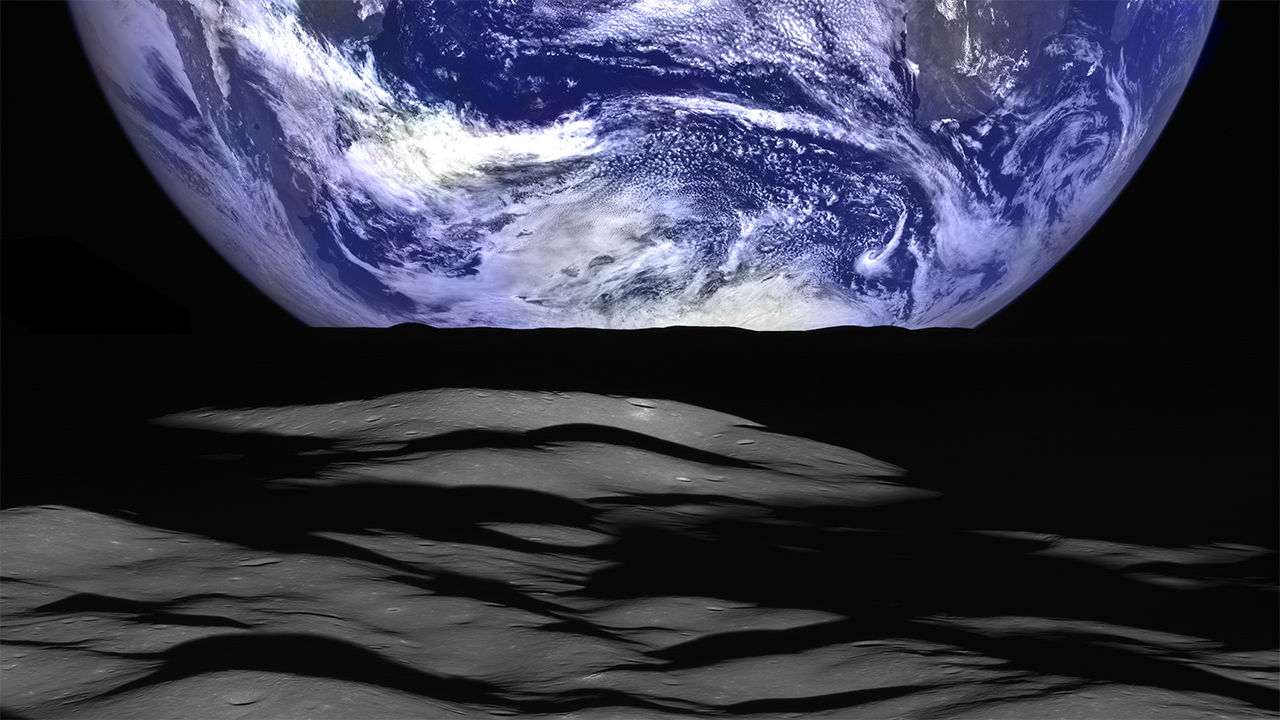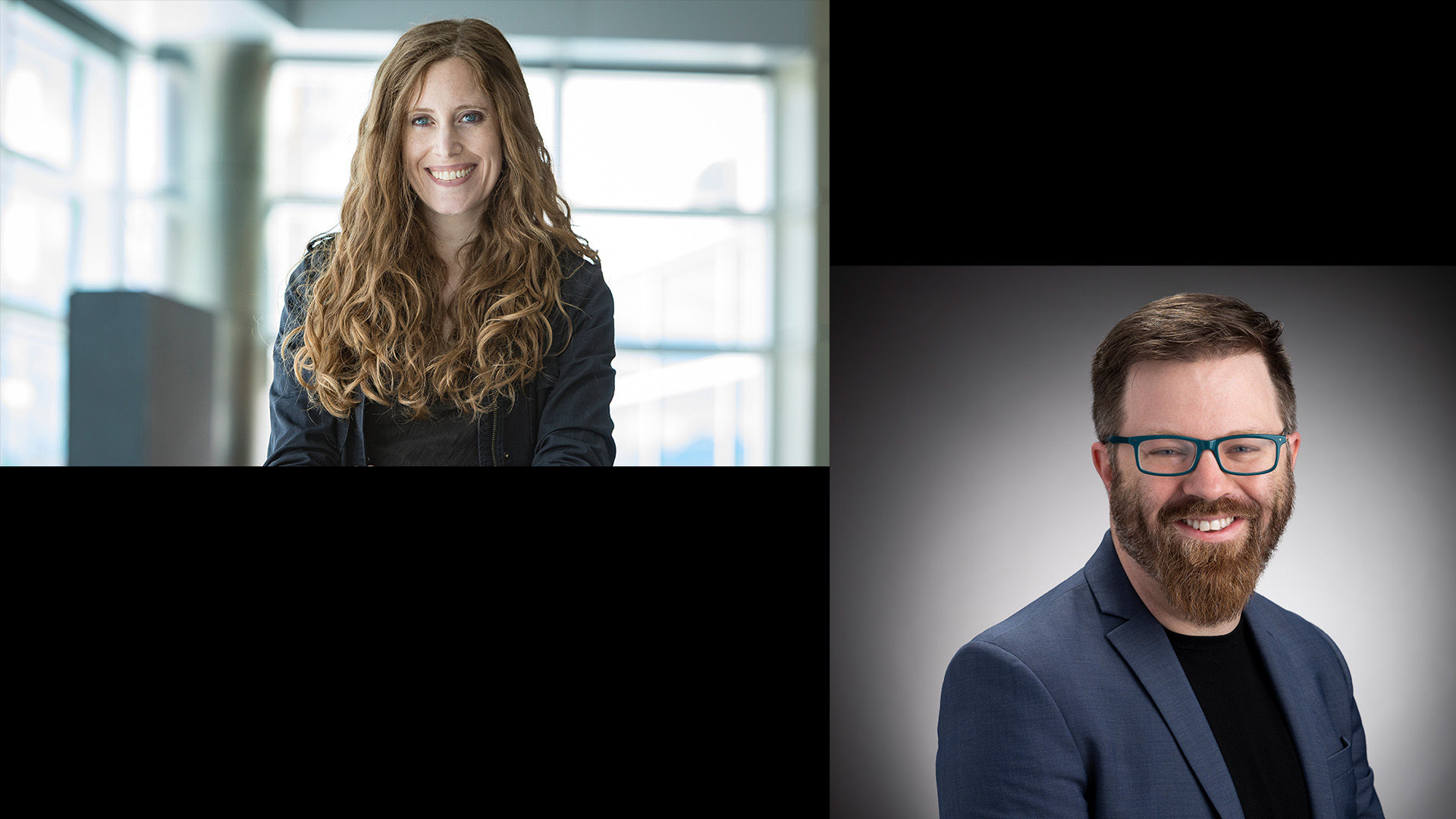Back to the Moon to Stay
Lunar Surface Innovation Consortium
Brett Denevi and Wesley Fuhrman
Johns Hopkins University Applied Physics Laboratory
About the Lecture

The Moon has been our partner in space for most of Earth’s history and holds a record of events spanning the past ~4.5 billion years. As the only other planetary body for which we have samples from a known geological context, the Moon has informed our understanding of the age of Earth, how planets form and evolve, and the impact flux that has shaped the Earth–Moon system. Yet despite its proximity, we have only barely begun our exploration of the Moon.
The Apollo era fueled 50 years of scientific studies and technological advances. It gave prominence to the field of planetary science, which allows us to appreciate the planets and asteroids as more than wandering points of light in the sky. As we move into the Artemis era, NASA and its international partners are working to build a long-term presence on the lunar surface that will yield extraordinary new science and be a proving ground for crewed missions beyond the Earth-Moon system.
Artemis base camp is expected to be at the lunar south pole, where ridges and crater rims provide long periods of low-angle sunlight. The abundant solar power here can enable extensive operations, including development of infrastructure and in-situ resource utilization engineering challenges far-afield from typical space exploration. Also within this region are craters with permanently shadowed regions, unexposed to the sun for billions of years and hovering at temperatures akin to the surface of Pluto. These dark, cold depths hold the promise of water ice, rich with science and a key re-source that can advance sustainment and exploration.
In this talk, we will cover the highest-priority science questions and the technologies that drive our exploration in the modern era of lunar discovery.
Selected Reading & Media References
Denevi, B. W. (2017) The New Moon, Physics Today 70, 6, 38; https://doi.org/10.1063/PT.3.3593
NASA Moon To Mars Objectives
https://www.nasa.gov/sites/default/files/atoms/files/m2m-objectives-exec-summary.pdf
NASA Lunar Surface Innovation Initiative: Ensuring a Cohesive, Executable Strategy for Technology
https://ntrs.nasa.gov/citations/20220013229
About the Speaker

Brett Denevi
Brett Denevi is principal staff scientist at the Johns Hopkins University Applied Physics Laboratory. Concurrently, she is Deputy Principal Investigator of the Lunar Reconnaissance Orbiter Camera, Co-Investigator on NASA’s ShadowCam instrument on the South Korea’s KARI Danuri orbiter, and Co-Investigator on the up-coming Lunar Vertex and Lunar-VISE missions, scheduled to land on the Moon in 2024 and 2026, respectively.
Previously, Brett served on the steering group of the recent National Academies Planetary Science and Astrobiology Decadal Survey, as Vice Chair for the Panel on the Moon and Mercury, and as the Science Chair of NASA’s Lunar Exploration Analysis Group.
Brett’s research focuses on the origin and evolution of planetary surfaces, particularly the volcanism, the effects of impact cratering, and space weathering.
Brett is an author on more than 90 technical papers on her work.
Among other honors and awards, she is the recipient of a NASA Early Career Fellowship and seven NASA group achievement awards. Asteroid 9026 Denevi is named in her honor.
Brett earned a BA in Geological Sciences at Northwestern University and a PhD in Geology and Geophysics at the University of Hawaii.
Wesley Fuhrman
Wesley Fuhrman is the lead for the Lunar Surface Innovation Initiative at Johns Hopkins Applied Physics Laboratory, a NASA Space Technology Mission Directorate initiative.
Wesley’s work at APL involves lunar and cislunar space, hypervelocity impact sensing and modeling, and advanced materials. His physics research focuses on condensed matter physics, in particular spectroscopy and theory of topological quantum materials; theory of strongly correlated materials; bulk crystal growth, characterization and analysis; and device fabrication on lab-grown single crystals.
Wesley is an author on several dozen technical publications on his work. Among other honors and awards Wesley was a Schmidt Fellow, prior to joining JHUAPL in his present capacity.
Wesley earned a BS in Physics at UC-Irvine and a PhD in Physics at The Johns Hopkins University.
Minutes
On December 16, 2022, from the Powell Auditorium of the Cosmos Club in Washington, D.C, and by Zoom webinar broadcast on the PSW Science YouTube channel, President Larry Millstein called the 2,469th meeting of the Society to order at 8:00 p.m. ET. He welcomed new members, and the recording secretary read the minutes of the previous meeting.
President Millstein then introduced the two speakers for the evening, Brett Denevi and Wesley Fuhrman from Johns Hopkins University Applied Physics Laboratory. Denevi is a principal staff scientist at APL. She is concurrently Deputy Principal Investigator of the Lunar Reconnaissance Orbiter Camera, Co-Investigator on NASA’s ShadowCam instrument on the South Korea’s KARI Danuri orbiter, and Co-Investigator on the up-coming Lunar Vertex and Lunar-VISE missions. Wesley Fuhrman is the lead for the Lunar Surface Innovation Initiative at APL.
Their lecture was titled, “Back to the Moon to Stay.”
Denevi began, as the first speaker of the evening, by reflecting on historical space events and enumerating currenting current space achievements. Denevi argued that Space Policy Directive 1 set the United States on the path towards funding and prioritizing Artemis. Denevi then emphasized the definition of sustainable exploration and explained that she will discuss the scientific discoveries that Artemis will make possible and that Fuhrman will discuss the commercial development and technology developments aspects of Artemeis.
Deveni then gave the two main themes for the scientific discoveries expected from the Artemeis program. First, a more thorough understanding of the history of the solar system, and second the water and volatiles on the moon.
Denevi then reviewed the previously accepted impact history of the earth and moon, which states there was a spiking event around 3.9 billion years ago, and the existence of a solar system wide heavy bombardment period. She then went on to reveal that this model was brought into question as higher fidelity images of the moon were taken through additional missions to the moon.
Denevi then went on the discuss the landing location of the Artemis mission. Specifically, Artmeis may land at the South Pole of the moon. The cold environment traps volatiles in the in the rock and will lend a map of the origins of water on the moon. The Artemis mission, Denevi explains, will get core samples in the permanently shadowed regions and preserve them at cryogenic temperatures to bring to earth and analyze.
Denevi then explained that the Artemis 3 astronauts will not have a vehicle, they will only be able to walk around the landing sights, so there will need to be an infrastructure built up. She uses this concept to bridge the talk into Fuhrman’s portion of the lecture.
Fuhrman begins by drawing the lesson that infrastructure allows for long duration science to take place, as seen with McMurdo Station in Antarctica.
Through the lunar station innovation initiatives, the speaker is working to understand what critical infrastructure is needed for long duration science on the moon. Fuhrman then explains the reliance NASA is growing on the commercial industry. And reviewed the geography of the lunar surface, specifically he focuses on Shackleton crater and regions of elongated illumination.
Fuhrman next reviewed some infrastructure for power on the moon. There are three methods of moving power around the lunar surface. They are Distributing the power, tethered power and power beaming. These methods are important considering the decreased efficacy of battery’s and fuel cells on the moon.
This power will be used for the creation of the infrastructure on the lunar surface. There will be 6 main technology areas to a sustainable lunar exploration base. These are the ability to leverage surface power, have extreme access, construct with excavated materials, perform in space resource utilization, mitigate dust, and survive extreme environments.
Next Fuhrman described an electrostatic dust shield, which is one of many approaches to dust mitigation. By applying a 3-phase electrode pattern, the electric potential differences will effectively walk dust off of materials such as solar panels. Fuhrman concluded with a short video of the lunar surface.
Next the question and answer period began. One of the members asked about error bars associated with impacts during the bombardment period. Denevi answered that the young rocks, less than 1 billion years old, are easier to date. However, the older rocks have experienced many impacts. So isotopic analysis are performed to identify estimated ages of the rock. Another member asks about the suite of nuclear technologies that may be used on the moon. Fuhrman responds by reviewing the different kinds technologies which supply different amounts of power. RTG, or radioisotope thermoelectric generators are used for deep space missions and use plutonium as a source. Fission, he then explains, would be a game changer for power generation.
A question from a member participating through Zoom asked about the longetivity of the space mission and the role of commercial industry. Fuhrman responded by emphasizing NASA’s collaboration with industry and desire to continue the public private partnership.
After the question and answer period, President Millstein thanked the speaker, made the usual housekeeping announcements, and invited guests to join the Society. President Millstein adjourned the meeting at 9:58 p.m.
Temperature in Washington, D.C.: 20° C
Weather: Partly Cloudy
Attendance: Attending in person: 39, concurrent live stream viewers: 39, for a total live viewership of 78, and the number of online viewers in the first two weeks of posting was, 359.
Respectfully submitted,
Cameo Lance, Recording Secretary